 |
 |
Yeovil Town 1960s Programmes |
 |
 |
 |

 Season 1959-60
Season 1959-60
|
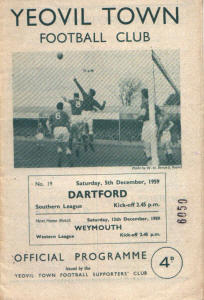
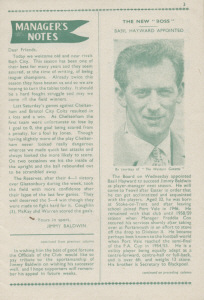
For a club that was to be a stalwart of the newly formed Southern League Premier Division for the next two decades the start was inauspicious to say the least. Apart from a 7-0 thrashing of Wellington there was scarcely a win before the end of October, and the Glovers were also knocked out of the League Cup, the County Cup and the F.A. Cup all at the first time of asking. Things turned around somewhat from November, and Yeovil were to finish comfortably mid-table, but there was nothing to play for as such and crowds suffered.
Jimmy Baldwin's time was up, and once again a new saviour was being sought by the board. Basil Hayward had spent the majority of his playing career at Port Vale (1946-1958) as a striker, changing to defence when his pace began to go. He'd spent a season at Portsmouth, before becoming Yeovil's seventh manager since the war at 32. He was appointed on April 13th, two days before Good Friday. The programme for the match that day v Bath City (No.34 top left) introduced him to the Yeovil public and explained that he'd be arriving after Easter to "get acclimatized and acquainted with the players", but that Baldwin would remain manager until the end of the season. The thoughts of Hayward and Baldwin on what potentially must have been a very tricky relationship are not recorded.
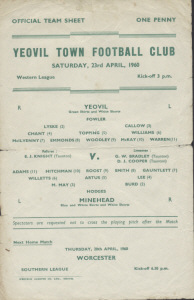
The programme cover (No. 19 top right) shown is from the league match v Dartford on December 5th which Yeovil won 3-0. It was a major change from the previous season's issue. There was a return to 16 pages, so features previously dropped like appearances and goal statistics and pen-portraits of the visiting team's players were back. The price went up to 4d to cover the extra costs. However the biggest change was that this season saw the first use of photographic material on the front of a Yeovil Town programme. The cover shot seen here remained the same throughout the campaign. Inside a Portrait Gallery appeared most weeks, with a 'portrait' photograph of the player featured.
Although some Reserve matches, those for the Western League Cup for example, still merited a full programme the declining interest in the Western League itself amongst spectators saw a move away from according many league games anything more than a single sheet - as shown bottom right. This comes from the last home game of the season for the Reserves against Minehead played on 23rd April, a 3-3 draw.
|

 Season 1960-61
Season 1960-61
|
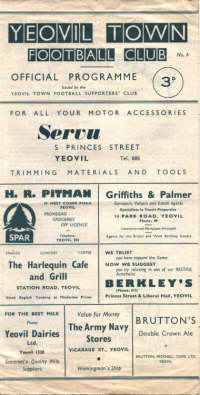 The most important moment of the close season was when a 20-year-old called Dave Taylor signed on the dotted line. He had come up through the Juniors at Gillingham, and had a season at Portsmouth before ariving at Huish. Taylor was lightening quick over the first few yards, excellent in the air, and a poacher who scored almost all his goals from close in. His first season with Yeovil saw him score 60 goals in all competitions for the First Team, a record one can not imagine will ever be broken. In all he would play 436 matches over nine seasons, netting 285 times. Another signing with a Gillingham connection was that of midfielder Bill Albury, for whom Hayward paid � 1,000. He would rack up 392 appearances over the next seven seasons, score 62 goals (he was the penalty taker for much of his time with the team), and become club captain.
The most important moment of the close season was when a 20-year-old called Dave Taylor signed on the dotted line. He had come up through the Juniors at Gillingham, and had a season at Portsmouth before ariving at Huish. Taylor was lightening quick over the first few yards, excellent in the air, and a poacher who scored almost all his goals from close in. His first season with Yeovil saw him score 60 goals in all competitions for the First Team, a record one can not imagine will ever be broken. In all he would play 436 matches over nine seasons, netting 285 times. Another signing with a Gillingham connection was that of midfielder Bill Albury, for whom Hayward paid � 1,000. He would rack up 392 appearances over the next seven seasons, score 62 goals (he was the penalty taker for much of his time with the team), and become club captain.
The team couldn't stop scoring, 152 goals in competitive matches at an average of 2.58 per game. Some particularly notable thrashings were: a 7-1 drubbing of the old enemy Weymouth in the Second Round of the Southern League Cup; 9-0, 7-0 and 10-0 wins over Wisbech Town, Hastings United, and Bedford Town respectively in the league; and a 8-1 destruction of Boston United, also in the league, from which game the programme illustrated (No.6) comes.
The last time Yeovil had used this format for its programmes was in the 1951-52 season: a single sheet folded in three to give six pages - page dimension 9 3/4" x 5". The only changing feature on the front cover was the issue number, the advertisement space being bought for the whole season. Inside there were the usual team line-ups, brief notes on the visiting players, Manager's and Supporters' Club notes, and table, but no space for a fixtures list or player statistics. One item of note in this particular example records the club's first recognition of an obligation to make provision for disabled supporters, with the Board of Directors agreeing that "anyone unlucky enough to attend games in an invalid carriage or disabled in other ways can be admitted to a section of the enclosure".
In the F.A. Cup Yeovil comfortably beat Trowbridge Town 4-0 away to make the First Round once again. A draw away to Walsall, unbeaten at home that season, looked a tough prospect, but a 1-0 win courtesy of Dave Taylor brought a money-spinning Second Round tie at Dean Court. Yeovil were well beaten 3-1 by Bournemouth & Boscombe Athletic on the day, but a share in the gate receipts from the 15,000 crowd softened the blow. The Southern League Cup campaign continued however, with Merthyr Tydfil, Hereford United and Guildford City going the same way as Weymouth. In the Final Yeovil took a 3-0 lead in the first leg at Huish, but the scoreline was reversed a week later at Chelmsford, and extra time couldn't resolve the destination of the trophy. Yeovil won the toss of a coin to host a replay, and another two goals from Taylor saw the Cup won for the first time since Ike Clarke's clean sweep of 1955. The County Cup was lost on a 4-6 aggregate to Minehead.
In the league the Glovers were in with a shout until late March. Top for two days after going to Oxford United (their first season under this new name, having previously been Headington United) and getting a 2-2 draw, three straight defeats blew any chances of another double and it was Oxford who took the Championship, Town eventually finishing third behind Chelmsford City.
All in all not quite as good as it might have been, but a very promising first season from the new manager.
|

 Season 1961-62 Programmes
Season 1961-62 Programmes
|
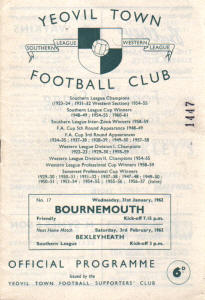 There were few changes to the squad as the 1961-62 campaign began. Terry Foley was the main acquisition. This was partially because Hayward was fairly happy with the team from the previous year, and partly because long simmering disagreements between the Board of Directors and the Supporters' Club had broken into open warfare, a war that was to last off and on for over a decade.
There were few changes to the squad as the 1961-62 campaign began. Terry Foley was the main acquisition. This was partially because Hayward was fairly happy with the team from the previous year, and partly because long simmering disagreements between the Board of Directors and the Supporters' Club had broken into open warfare, a war that was to last off and on for over a decade.
The Supporters' Club had generally been meeting around a third of the club's running costs for years, but was consistently denied representation on the board. There was increasing disenchantment with the majority of their hard raised cash disappearing into general expenses, and the board repeatedly prevaricating over ground improvements. The two projects closest to the Supporters' Club's heart was a proposal to level the Huish slope, and the covering of the end terraces. It was probably one of those arguments where both sides had a case. The Supporters' Club line was that without money spent to create a top class stadium Yeovil Town would never get elected to the Football League; the board's line was that without money spent to create a quality team Yeovil Town wouldn't be in a position to be serious contenders for election in the first place. The Supporter's Club offered a loan, the directors refused, demanding the money be gifted. The Supporter's Club wouldn't budge, so the board accused it of denying Hayward a decent playing budget and hiked ticket prices up to 2/6d (prices had increased to 2/- only the season before). The board also withdrew the rights to the Jackpot scheme, the Supporters' Club's biggest money raiser, saying it could only recover them for a payment of � 2,000, at � 125 a month. Relations soured further. Eventually a deal was hammered out in January, but much bitterness had been engendered by all parties to little purpose. The Supporters' Club did offer to pay for the upgrading of the floodlights to League standard. Having nailed their colours to the 'team as priority over stadium' mast the Board of Directors did a complete U-turn at season's end and decided to build a new Main Stand, complete with clubhouse, dressing rooms and offices, to replace the old stand brought to Huish from the Pen Mill ground.
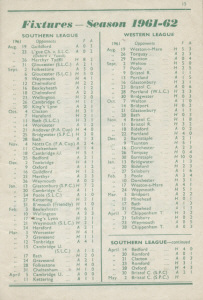
On the pitch it was a solid rather than spectacular season. The First Round of the F.A. Cup was reached again, and Yeovil put in a good performance in going out away to Notts County. The team reached the semi-final stage in defence of the Southern League Cup, going out 3-1 away to Cambridge United. The only silverware was in the County Cup, where Bristol City were defeated 2-1 away and 3-0 at home (No.29, right).
The league campaign faltered in a poor run in December, and Oxford United were Champions again, Yeovil finishing fourth. There was huge excitement generated throughout Non-league football by the mid-season demise of Accrington Stanley, as for once there would be a guaranteed place in the election process for new blood. A staggering twenty-six Non-league clubs put their names forward. League clubs Chester, Doncaster and Hartlepools were re-elected, and Oxford United secured the place vacated by Accrington.
The programme had returned to the 16 page booklet format, the price doubling to 6d. A green and white quartered shield with football made its first appearance on the front cover. Underneath all the club's honours to date were listed. The increased space allowed the return of a fixture list for both First Team and Reserves, player statistics, and a "Do You Remember?" feature on past players. The example shown (top left) is issue No.17 for a friendly against Bournemouth, then managed by Bill McGarry, played on 31st January. Yeovil won 1-0. This was supposed to be the first in a series of money raising friendlies, but less than 2,000 fans turned up and no more were arranged.
|

 Season 1962-63
Season 1962-63
|
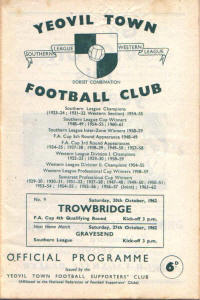 There was no change in the programme for 1962-63. Little change to the squad either. Alan Herrity from Newport County, who would eventually reach No.2 in the all-time appearances list, was the most notable signing.
There was no change in the programme for 1962-63. Little change to the squad either. Alan Herrity from Newport County, who would eventually reach No.2 in the all-time appearances list, was the most notable signing.
Yeovil used metal goal posts for the first time this season, but of rather greater significance was the plan for the Main Stand. It had now reached the drawing board, and a 2,000 seater costing �20,000 for the first phase alone was emerging from the architect's office. It eventually cost the club nearer �50,000. My first ever Yeovil game was seen from that stand in the Sixties, and although I moved to the terraces on reaching my teens I loved it, as I loved every increasingly crumbling piece of concrete and rusting girder in Huish, until its demolition in 1990.
After two years of fair success Hayward's third season got off to a dreadful start and by October the Glovers were bottom of the league and out of the Southern League Cup. As so often the F.A. Cup brought some respite from criticism for a Yeovil manager. The programme chosen for this season is from the Fourth Qualifying Round, when Trowbridge Town were beaten 4-0, Terry Foley scoring a hat-trick. In the next round Dartford were defeated 3-2, Yeovil having to come back from a 0-2 deficit. The draw for the Second Round brought Swindon to Huish. A crowd of 12,292 saw the visitors win 2-0.
With the Cup out of the way the team needed to concentrate on improving their league position. But on Boxing Day night 1962, after a 1-1 draw at home to Bedford Town, the biggest blizzard of the century hit the South of England, and the whole region was a white-out. For days nothing moved on the roads - except my father, who for reasons he can't recall had seen fit to purchase a set of snow chains in a sale a few months previously. School was closed for weeks. Yeovil Town did not manage another competitive game for seven weeks, and the next match at Huish was on February 23rd. The fixture backlog was horrendous. At one point Yeovil found themselves playing four First Team matches on consecutive days. The last part of the season also saw the team travelling almost continuously. With contracts already exchanged work had to begin on the new stand, fixture backlog or no fixture backlog, and the club played most of its fixtures in the last months of the season away. Results were sufficiently good to see Yeovil secure a mid-table finish.
The only silverware of the season came in the Somerset Professional Cup and another winning Final over two legs versus Bristol City. However the public's tastes were changing and the days were gone when the County Cup attracted big crowds. Only just over 2,000 watched the two ties.
As a poor campaign drew to a close Basil Hayward maintained, as he had all season, that he'd collected an exceptional squad of players and all that was needed was the spark to get them going as a team. The Yeovil faithful, impatient as ever, were unconvinced. Basil however had other things on his mind than fan discontent as he was on the verge of becoming a father for the first time.
|

 Season 1963-64
Season 1963-64
|
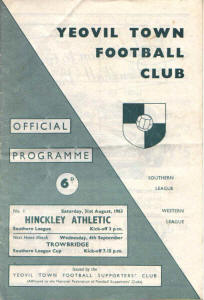 Over the summer the new stand took shape. The club asked for its first two fixtures to be away to give the builders a few extra days. Both were lost. Saturday 31st August 1963 was a day of 'firsts'. The opponents Hinckley Athletic were newly promoted, and it was their first ever visit to Huish. The Main Stand, fixtures and fittings far from complete, was open to fans for the first time for a First Team game, though it had been used for a Reserve match a week previously. Cushions were made available for the less well padded behind, a free trial for this opening league match, 6d thereafter. And there was a new programme (right) produced by the new Supporters' Club secretary, Bryan Moore. He had begun contributing articles regularly the previous season under the name "Old Moore". It's doubtful Bryan knew then what he was letting himself in for - he would be involved in producing the Yeovil Town programmes for the next thirty-six years. The match was won 8-1, with Dave Taylor hitting five.
Over the summer the new stand took shape. The club asked for its first two fixtures to be away to give the builders a few extra days. Both were lost. Saturday 31st August 1963 was a day of 'firsts'. The opponents Hinckley Athletic were newly promoted, and it was their first ever visit to Huish. The Main Stand, fixtures and fittings far from complete, was open to fans for the first time for a First Team game, though it had been used for a Reserve match a week previously. Cushions were made available for the less well padded behind, a free trial for this opening league match, 6d thereafter. And there was a new programme (right) produced by the new Supporters' Club secretary, Bryan Moore. He had begun contributing articles regularly the previous season under the name "Old Moore". It's doubtful Bryan knew then what he was letting himself in for - he would be involved in producing the Yeovil Town programmes for the next thirty-six years. The match was won 8-1, with Dave Taylor hitting five.
The programme had a new cover, with a simple diagonal division into green and white halves. The shield was retained, but the text was much reduced, giving the whole thing a cleaner simpler look. Inside the 16 pager the format was much as before, but in his opening notes Bryan was already indicating that his love of statistics and the history of the game would soon be influencing content: 'The programme has increased editorial material and new articles this season. "Facts and figures" will contain what we hope will be interesting facts on football; "Portrait Gallery" will give a detailed pen-picture of each member of staff. "The Last Time They Met at Huish" is another article which will be appearing in all issues after this one.'
After those first two losses whatever spark it was Hayward had been looking for well and truly caught light. It could have been that Ken Pound, an eighteen-year-old winger signed from Portsmouth, was the last piece in the jigsaw. Yeovil were not defeated again until Boxing Day and the goals were flying in in quantity. The side stormed through the first four rounds of the Southern League Cup, 16 goals for, 5 against, and hammered 14 in the first two County Cup ties with no reply. The F.A. Cup saw Yeovil's best run for six years. The Fourth Qualifying Round occasioned a rare occurrence for the club: a draw away to Cowes saw a first trip in the F.A. Cup to the Isle of Wight. It occasioned a 100% overseas record, Yeovil winning 1-0. The next round saw Southend United knocked out by the same score at Huish. Crystal Palace were next out of the hat, but five days before the tie the manager announced he would be leaving Yeovil Town. Bedford Town had offered him �15 a week more, and although Hayward gave the board the chance to match it and retain his services they decided to release him, with the proviso that he didn't depart until the F.A. Cup run ended. "Notes from the Boardroom" in the programme for the game made only cryptic reference to the turmoil behind the scenes, even though Hayward had already gone public. Older fans often recall this as one of their favourite matches of all time, and the national press described it as one of the best performances by a Non-league side against League opposition ever. Palace were simply played off the park as 10,925 saw Yeovil win 3-1. The result also meant the manager's departure was delayed until at least January. Between the victory over Palace and the arrival of Bury in the Third Round the post-war record of unbeaten matches was further extended, and second placed Yeovil went into two fixtures against league leaders Romford over Christmas brimming with confidence. However the 24 match sequence was ended in the away game, and the Glovers could only draw in the return at home. Romford were now ten points clear, though they had played four more games. Back in the F.A. Cup Yeovil bowed out 2-0 to Bury, and were defeated 3-2 by Weymouth in the Southern League Cup but Hayward kept the title race ticking over. His last game in charge was, by one of those strange quirks of fortune, against Bedford Town on February 1st. Yeovil won 1-0.
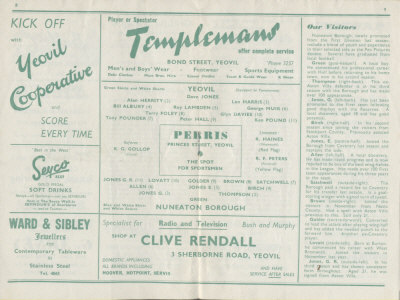
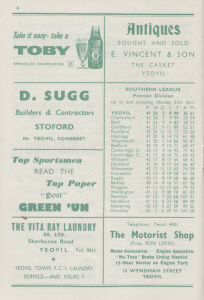
Eleven candidates had been interviewed for the vacant post, and the job went to Glyn Davies, captain of Derby County. A loss to Dartford was followed by six straight wins. Romford meanwhile had collapsed completely, they would finish a distant fifth, and Chelmsford City and Bath City were the main rivals. A hiccup of two defeats in mid-March saw a few worried faces at Huish, but then the team went on another undefeated run of eight wins and a draw to clinch the title at home to Nuneaton (No.30, left) on April 22nd, with two games to spare. The last league game of the season was home to Weymouth (No.31, right), and as well as being beaten 3-1 they had to endure the sight of the Southern League Championship Shield being presented to Yeovil Town. Sandwiched each side of this game was yet another two-legged Somerset Professional Cup Final against Bristol City. The Robins took it 4-2 on aggregate.
|

 Season 1964-65
Season 1964-65
|
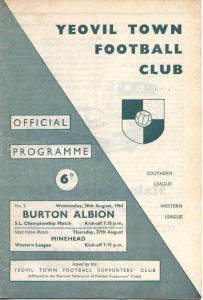 Although the hugely talented young left-winger Ken Pound, the main source of supply for Dave Taylor's 48 and Terry Foley's 30 goals the previous year, was lost to Swansea in the close season the defending Champions came out of the traps like a greyhound. The programme on the left (No.2) is from the Southern League Challenge Cup between Yeovil Town as title holders and Burton Albion as Cup holders. A 4-1 victory put more silverware in the cabinet by August 26th. As the team went into the F.A. Cup Fourth Qualifying Round away to Salisbury City on October 17th the only defeat was in the first leg of the Southern League Cup away to Trowbridge Town; a matter conclusively rectified in a 5-1 victory at Huish in the return leg. The short trip was a disaster, Salisbury winning 2-1. With no potential First Round money spinner for the first time in five years Yeovil's finances, always on a knife edge and with the new Main Stand still being paid for, were plunged into chaos. To make matters worse top goal scorer Dave Taylor was out with a long term injury. The club was still within touching distance of league leaders Weymouth at Christmas, but a 1-0 defeat to the Terras at Huish on Boxing Day saw the title slipping away, Town eventually finishing fourth. Further problems struck at home to Tonbridge AFC on January 9th. Yeovil's other main striker Terry Foley received a punch that broke his jaw, and the two points from a 1-0 win were scant consolation. The game ended with Yeovil and Tonbridge players and supporters fighting across the Huish pitch. When the Glovers went out of the Southern League Cup to Hillingdon Borough in a Fourth Round replay on February 17th the season was effectively over, though the club did win the Somerset Professional Cup, defeating Minehead.
Although the hugely talented young left-winger Ken Pound, the main source of supply for Dave Taylor's 48 and Terry Foley's 30 goals the previous year, was lost to Swansea in the close season the defending Champions came out of the traps like a greyhound. The programme on the left (No.2) is from the Southern League Challenge Cup between Yeovil Town as title holders and Burton Albion as Cup holders. A 4-1 victory put more silverware in the cabinet by August 26th. As the team went into the F.A. Cup Fourth Qualifying Round away to Salisbury City on October 17th the only defeat was in the first leg of the Southern League Cup away to Trowbridge Town; a matter conclusively rectified in a 5-1 victory at Huish in the return leg. The short trip was a disaster, Salisbury winning 2-1. With no potential First Round money spinner for the first time in five years Yeovil's finances, always on a knife edge and with the new Main Stand still being paid for, were plunged into chaos. To make matters worse top goal scorer Dave Taylor was out with a long term injury. The club was still within touching distance of league leaders Weymouth at Christmas, but a 1-0 defeat to the Terras at Huish on Boxing Day saw the title slipping away, Town eventually finishing fourth. Further problems struck at home to Tonbridge AFC on January 9th. Yeovil's other main striker Terry Foley received a punch that broke his jaw, and the two points from a 1-0 win were scant consolation. The game ended with Yeovil and Tonbridge players and supporters fighting across the Huish pitch. When the Glovers went out of the Southern League Cup to Hillingdon Borough in a Fourth Round replay on February 17th the season was effectively over, though the club did win the Somerset Professional Cup, defeating Minehead.
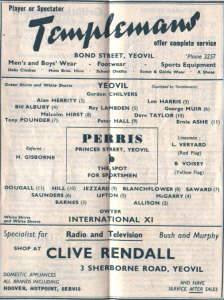 Perhaps surprisingly there was no redesign of the programme cover to recognise Yeovil Town's Championship the previous season. This was only rectified near the end of the season when a small legend was added listing Yeovil's Southern League titles (see example for 1965-66). Inside the editorial content continued to expand. The most interesting additional feature was an in depth statistical analysis of each preceding game. Mr. Moore was decades ahead of the OPTA Index! The programme (No.23) on the right shows the team line-ups for the official opening (nearly two full seasons after it began to be used) of the Main Stand on March 22nd. An International X1 including the likes of Jimmy Hill, Danny Blanchflower and Malcolm Allison attracted a crowd of 2,682, the hosts winning 3-0. Bryan's hard work on improving the content was recognised when it was judged the tenth best programme in the British Isles, the only Non-league issue to make the top ten.
Perhaps surprisingly there was no redesign of the programme cover to recognise Yeovil Town's Championship the previous season. This was only rectified near the end of the season when a small legend was added listing Yeovil's Southern League titles (see example for 1965-66). Inside the editorial content continued to expand. The most interesting additional feature was an in depth statistical analysis of each preceding game. Mr. Moore was decades ahead of the OPTA Index! The programme (No.23) on the right shows the team line-ups for the official opening (nearly two full seasons after it began to be used) of the Main Stand on March 22nd. An International X1 including the likes of Jimmy Hill, Danny Blanchflower and Malcolm Allison attracted a crowd of 2,682, the hosts winning 3-0. Bryan's hard work on improving the content was recognised when it was judged the tenth best programme in the British Isles, the only Non-league issue to make the top ten.
Off the pitch the contentious decision was whether to resign from the Western Division after 46 years. The club's finances were rocky and the Reserves were losing money. Davies was keen to enter the proposed Western Counties Floodlight League, which would start the following season. In February the board agreed, and the Reserves played what was supposed to be their last ever Western League fixture on April 28th, losing 3-2 away at Glastonbury. The Reserves were entered into the Dorset Combination for the following season. Little is simple at Yeovil Town and the issue of the Western and Floodlight Leagues was to be a battleground within the club for years to come.
A Junior Section of the Supporters' Club was begun during the season. Membership was 1/-, and open to any fans from 0-17.
Rumours began to circulate that Glyn Davies was off to the Vetch. These were vigorously denied by the club.
|

 Season 1965-66
Season 1965-66
|
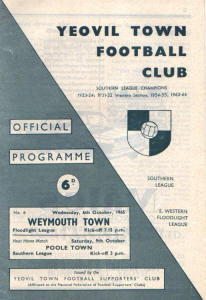 So off he went. On June 30th Yeovil accepted �1,250 from Swansea. Trainer Stan Abbott was also gone, into retirement, after 46 years with The Glovers.
So off he went. On June 30th Yeovil accepted �1,250 from Swansea. Trainer Stan Abbott was also gone, into retirement, after 46 years with The Glovers.
The new manager was Joe McDonald, most recently with Ramsgate as player-manager. His playing career had taken in Falkirk, Sunderland and Nottingham Forest.
Admission prices were up again, to 3/-, and the season started patchily. The programme (No.6, left) is for the first ever South-Western Floodlight League match, played against Weymouth (not "Weymouth Town" as printed) on October 6th. Yeovil's opening goal in the competition was dispatched from the penalty spot on 28 minutes by Bill Albury after Dave Taylor was brought down. Second half goals by Taylor and Terry Foley completed the 3-0 win. A crowd of 3,153 saw the launch of the competition, but this enthusiasm would not be maintained. The Floodlight League had a very different points system from the then standard two for a win, one for a draw. An away win was awarded four points, a home win three; an away draw two points, a home draw one. The idea was to reward attacking football by visiting sides. Eight clubs had entered: Bath City, Cheltenham Town, Exeter City, Plymouth Argyle, Poole Town, Torquay United, Weymouth and Yeovil Town. The combination of League and Non-league sides was supposed to add extra interest for both camps, with new opponents to play, but it quickly became clear that the League clubs were ignoring the rules and playing weakened sides. With ticket prices the same as for the main league matches interest from the paying public began to tail off. Yeovil Town were perhaps the only club who took the competition seriously, winning the league by a margin of 15 points. Four teams did not even complete their fixtures.
In the knock-out competitions Yeovil made Round 1 of the F.A. Cup after needing a replay against Portland United (No.8, lower right), 6,005 turning up at Huish for the first F.A. Cup tie to be played under lights at the ground. A tough and unsuccessful trip to Brentford was the reward, the Glovers losing 2-1. World Cup fever was already gripping, with the pages shown dedicated to informing supporters of how they could obtain tickets.
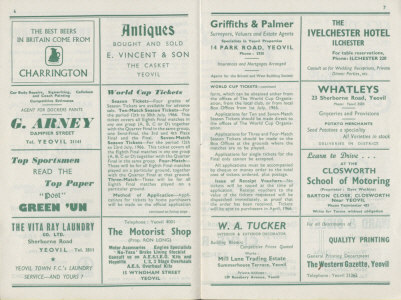 The League Cup run went right through to the end. In the semi-final Yeovil visited Hastings United and battled out a 2-2 draw, taking the Sussex club in the replay 3-1. The Final was a tight affair: Yeovil took a slender one goal lead to Guildford, after beating City at Huish 2-1, and a 0-0 draw was enough to take the Southern League Cup for the fourth time. The fairly regular County Cup Final appearance did not occur, the Glovers having been knocked out back in the Second Round by Bath City.
The League Cup run went right through to the end. In the semi-final Yeovil visited Hastings United and battled out a 2-2 draw, taking the Sussex club in the replay 3-1. The Final was a tight affair: Yeovil took a slender one goal lead to Guildford, after beating City at Huish 2-1, and a 0-0 draw was enough to take the Southern League Cup for the fourth time. The fairly regular County Cup Final appearance did not occur, the Glovers having been knocked out back in the Second Round by Bath City.
The Premier Division campaign stuttered along, and the team finished ninth. Yeovil scored the highest number of goals by some margin, but the defence was far too leaky. The Reserves issue was boiling up nicely. The Dorset Combination proved far too uncompetitive a league. Although Yeovil Reserves only came second they racked up a host of almost embarrassingly large wins across the season. The Combination League Cup was eventually won after a second replay against the title winners Parley Sports in the semi-final took Town to a Final against Vickers. George Muir claimed to be so insulted by the standard that when he was told to play a Reserve fixture he put in a transfer request. With the club still having to find a further �16,000 to pay for the stand the board was split over what to do with the Reserves, with a strong faction wishing to disband them. Eventually in March it was decided to return to the Western League. The decision cost Yeovil Town its out voted Chairman, Stanley Pinder resigning in protest.
|

 Season 1966-67
Season 1966-67
|
|
In the summer Bryan Moore resigned as Supporters' Club secretary to take over the position of treasurer to the Football Club. With �2,500 lost the season before and a �27,000 overdraft he had plenty of challenges. Ken Little became the new secretary, and with it had responsibility for the programme, though Moore still contributed a significant amount of material. The long-running tensions between the Supporters' Club and the Board of Directors broke out into the open again when Little used his position as secretary to launch a stinging attack on the board at the Shareholders' AGM, complaining of a lack of liaison by the directors, poor facilities at the Social Club, lack of effort from the club over the lottery, and resentment over the way Moore had been moved from the Supporters' Club to the Football Club. Such was the ferocity of Little's accusations, Supporters' Club chairman Edgar Blake felt it necessary to make it clear they were his personal views and not those of the Supporters' Club. However battle lines were being drawn, and it would become harder and harder in the coming years to avoid being in one camp or the other.
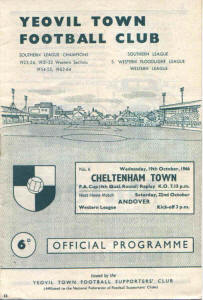
The first few programmes continued with the front cover used for the previous three seasons, until a new design was introduced featuring a sketch of Huish looking towards the Brewery End. Content was much as before, and the editorial / advertisement mix remained about 50/50. The programme shown on the left is from the F.A. Cup Fourth Qualifying Round replay against Cheltenham Town (No.6). The first match had been a 3-3 thriller. The crowd at Whaddon Road was 3,047, the highest for some years. A large and vocal Yeovil contingent of 600 travelled, and the manager and players saw fit to congratulate the fans for their committed support. Yeovil found the replay more comfortable, running out 3-1 winners in front of 4,444. The prize was a visit by Oxford United, a Non-league club only a few seasons earlier. There was no glorious cup run as Oxford won 3-1, but 7,530 through the gates helped cash flow. The Fourth Round of the Southern League Cup was reached but, after two very closely fought games 1-1 and 3-3 AET with Chelmsford City, Yeovil collapsed in the second replay to a 6-0 defeat. The club was in the Final of the County Cup again, but a 1-1 draw did not overturn a 1-2 lead Frome had brought to Huish for the second leg. The Floodlight League was meandering along with only five teams, all the League clubs and Cheltenham having withdrawn, but Salisbury City having joined. Performances in the Southern League were up and down - but mostly down, and Yeovil finished a lowly 14th. One substitute, introduced into the Football League and the F.A. Cup the previous season, was allowed in the Southern League for the first time. Up to the start of the 1967-68 season the substitute could only replace an injured player, thereafter substitutions could be made for tactical reasons.
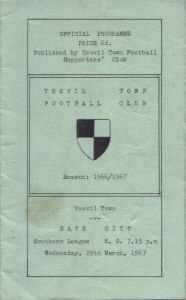 One might express surprise that the team was performing at all. On Monday 23rd of January, ahead of the home derby match with Weymouth, a board meeting decided that the services of manager Joe McDonald would be dispensed with at the end of the season. He was informed by letter, and to say he took it badly would be an understatement. Manager's Notes disappear from the programmes from that point and, after a series of verbal clashes with the chairman, McDonald was told to leave the club with immediate effect in March. Unhappiness was by then rife within the team, and long serving pro George Muir was fined and suspended for swearing at one of the directors. The programmes make sorry reading during this period, with the Broadroom Notes and Supporters' Club Notes alternating between thinly veiled feuding, chopping and changing of policy, and gloomy prognostications that the club was heading for financial oblivion. What the poor fans, the readers, constantly exhorted to keep turning up with the implication it would be their fault if the club went under, made of all this is anyone's guess. What was obvious was that the club was in an awful mess, with a lack of clear leadership from above.
One might express surprise that the team was performing at all. On Monday 23rd of January, ahead of the home derby match with Weymouth, a board meeting decided that the services of manager Joe McDonald would be dispensed with at the end of the season. He was informed by letter, and to say he took it badly would be an understatement. Manager's Notes disappear from the programmes from that point and, after a series of verbal clashes with the chairman, McDonald was told to leave the club with immediate effect in March. Unhappiness was by then rife within the team, and long serving pro George Muir was fined and suspended for swearing at one of the directors. The programmes make sorry reading during this period, with the Broadroom Notes and Supporters' Club Notes alternating between thinly veiled feuding, chopping and changing of policy, and gloomy prognostications that the club was heading for financial oblivion. What the poor fans, the readers, constantly exhorted to keep turning up with the implication it would be their fault if the club went under, made of all this is anyone's guess. What was obvious was that the club was in an awful mess, with a lack of clear leadership from above.
Symptomatic was the shambles of the Reserves. A sub-committee, presumably having listened to the advice of the treasurer that disbandment of the Reserves would save �1,000 a season, recommended the Western League side be discontinued. It also proposed that a Team Manager and a General Manager be appointed to separate out on and off-field duties. A few weeks later the board announced the club would stay in the Western league, and a few weeks on again on April 19th that Ron Saunders would be the next manager. No General Manager was appointed. Further, the board took it upon itself to decide on the retained list a few days before appointing Saunders. There were only two names on it, though six other players were offered reduced terms.
The programme on the right is included because, for reasons no longer clear, a number of issues in this format were produced at irregular intervals during the season. The same width as the normal programme, they are half an inch higher. Still 16 pages, these were created on a typewriter, and reproduced on thick light green low grade non-gloss paper. There was no advertising at all and, coincidentally or not, no contributions from any official representatives of the Football Club are apparent, only the Supporters' Club. They were published by the Yeovil Town Football Supporters' Club itself, rather than the Western Gazette which had been printing the programmes since the War. It was a style of issue that most commonly appears for lesser competitions like the Floodlight League, but the example shown comes from a Southern League fixture against Bath City played on March 29th. The match ended 1-1.
|

 Season 1967-68
Season 1967-68
|
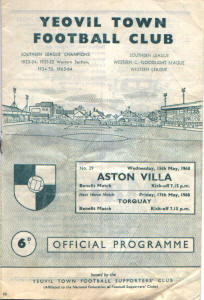 This was Saunders' first managerial post. His League playing career had involved Everton, Portsmouth, Watford and Gillingham, and finished at Carlton Athletic. The first priority was to get a new team together, and the ins and outs were still going on into October, and in fact continued at a reduced rate all season. Given the rebuilding things started well on the pitch, with Yeovil leading the league at the end of September, and still third in October. However off the pitch troubles continued. Ron Saunders was never a warm nor diplomatic character and took a major dislike to the Floodlight League. Tensions with the board were evident from very early. The board itself, to make a change from feuding with the Supporters' Club, was engaged in some internal blood letting. The disagreements between ex-chairman Stanley Pinder and current chairman Edmund Templeman were brought to a conclusion when Pinder was voted off, along with Ernie Barber. Ted Loney and Len Pearce also went in the purge, not offering themselves for re-election. Club treasurer Byran Moore was given director status, and new faces brought in were Norman Burfield, Edward Mear, and J.W. Selby (the latter only serving for one season). Whatever resentments Ken Little had felt the previous season about Moore's move to working inside the club as treasurer was obviously not personal, as the Supporters' Club Notes penned by him for issue No. 5 (v Hillingdon Borough on 13th September) reveal that he was one of the two shareholders nominating Bryan for a position on the Board of Directors. "ACTION, NOT WORDS and obviously Mr. Moore was my choice, new blood, not dead wood." In a 'Stop Press' Little welcomed the new personnel as the "Wind of Change" and a "White Tornado". He was right that there was a hurricane brewing, and over the next few years it would rip the club apart and come close to destroying it.
This was Saunders' first managerial post. His League playing career had involved Everton, Portsmouth, Watford and Gillingham, and finished at Carlton Athletic. The first priority was to get a new team together, and the ins and outs were still going on into October, and in fact continued at a reduced rate all season. Given the rebuilding things started well on the pitch, with Yeovil leading the league at the end of September, and still third in October. However off the pitch troubles continued. Ron Saunders was never a warm nor diplomatic character and took a major dislike to the Floodlight League. Tensions with the board were evident from very early. The board itself, to make a change from feuding with the Supporters' Club, was engaged in some internal blood letting. The disagreements between ex-chairman Stanley Pinder and current chairman Edmund Templeman were brought to a conclusion when Pinder was voted off, along with Ernie Barber. Ted Loney and Len Pearce also went in the purge, not offering themselves for re-election. Club treasurer Byran Moore was given director status, and new faces brought in were Norman Burfield, Edward Mear, and J.W. Selby (the latter only serving for one season). Whatever resentments Ken Little had felt the previous season about Moore's move to working inside the club as treasurer was obviously not personal, as the Supporters' Club Notes penned by him for issue No. 5 (v Hillingdon Borough on 13th September) reveal that he was one of the two shareholders nominating Bryan for a position on the Board of Directors. "ACTION, NOT WORDS and obviously Mr. Moore was my choice, new blood, not dead wood." In a 'Stop Press' Little welcomed the new personnel as the "Wind of Change" and a "White Tornado". He was right that there was a hurricane brewing, and over the next few years it would rip the club apart and come close to destroying it.
Yeovil had often tended to be too reliant on income from the F.A. Cup, and with finances in one of their regular parlous states a good run this season was especially important. Welton Rovers were disposed of 2-0, but there was disappointment when fellow Southern League club Margate were drawn in Round 1. Still the fixture was at home, and when the first attempt was postponed due to bad weather Yeovil went into the rearranged game knowing a lucrative tie against Peterborough United awaited. 6,322 turned up on a Wednesday night, but the match was lost 3-1. Yeovil were still in the Southern League Cup, eventually going out 1-0 away to Ramsgate at the semi-final stage. And in that score-line lay one of the problems. Football was changing rapidly. At the start of the decade many teams were still playing five forwards, and Yeovil fans had grown up with a club with a tradition of making attacking a virtue and rather letting the defence take care of itself. Saunders was the first manager at Yeovil Town to play with a lone striker, and the supporters were not happy. Neither was Dave Taylor, who asked for a transfer, saying the new system did not suit his game. The unhappiness was spreading through the squad. Two players fought each other on the pitch in the 8-2 rout at Whaddon Road on February 10th. Goalkeeper Ken Jones was reprimanded for swearing at home fans after a 2-1 defeat to Bournemouth in a Floodlight League game, and in the very last game of the season away to Poole in the same competition let in five goals in an eleven minute spell during a 7-1 defeat. Saunders was forced to substitute him with an outfield player. He was accused of making no effort to stop them, and in an emergency meeting of the Board fined the maximum two weeks wages, though rather surprisingly he wasn't released. Despite the debacle at Poole the Glovers did win the Floodlight title. There was a Final appearance in the County Cup, but Yeovil lost both legs to Bath City, failing to score a goal. It was another mid-table finish in the league, 12th, and the 45 goals scored were by far the lowest total since the War. The Reserves finished bottom of the Western League for the second year running, winning five matches all season.
Although the boardroom changes had removed some of those wanting to radically review the Reserve structure at the club, the increasingly desperate financial situation still saw the directors split on the issue. After much argument the chairman got his way and won the vote to enter the Western League and the Floodlight League the following season. The manager grew even more unhappy that his opinions had been ignored. An Extraordinary General Meeting of Shareholders was called for May 27th to legalise the issue of additional share capital to keep the club afloat. The sale of the housing for players Yeovil had built up over the years began, with three properties disposed of.
The issue shown is the second last of the season (No.29) from the 15th of May, a testimonial game for George Muir and Alan Herrity who had both reached six years with the club, against Aston Villa. In a season of some mayhem at least there were no changes in the programme to report.
|

 Season 1968-69
Season 1968-69
|
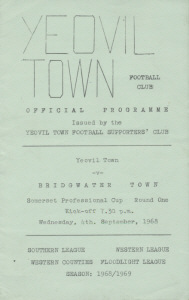 If the previous seaon had seen strife within the club this one was to produce open warfare.
If the previous seaon had seen strife within the club this one was to produce open warfare.
Over the summer Supporters' Club treasurer Bill Fearn was forced to quit, accused of leaking information about the club's desperate position to the media. Supporters' Club chairman Tony Coles resigned, claiming irreconcilable differences within the club. Don Osborne stepped up from vice-chairman to chairman, and committee member J.Affleck took over as treasurer. Another four committee members resigned for various reasons. Elsewhere the in-fighting continued too. At the Sharholders' AGM a motion of no confidence, led by Stanley Pinder, was put down against club chairman Edmund Templeman and his brother-in-law and vice-chairman Cyril Farthing. Both survived. Albert Lukins was voted onto the board to replace Selby, and Ivan Rendall, football club secretary since 1948, replaced R.G.White, who we last saw producing the programme in the late Forties and early Fifties, and who had been vice-chairman of the football club during the Fifties.
Only five players had been released, which was fortunate as with all the battles going on the board didn't get round to fixing Saunders' budget until the end of August, and he'd only been able to sign a couple of make-weights in the close season. The campaign started with four draws and then a loss, but began to pick up as Dave Taylor was back scoring again. However any illusion of harmony was soon shattered as another simmering crisis exploded. The manager had always made it clear he resented involvement in the Floodlight League and as the first fixture in the competition approached, at home to Weymouth on October 2nd, Saunders announced he would be fielding a reserve side and had better things to do than attend himself. He was called before the Board of Directors and after two stormy meetings was ordered to field his strongest side and be at the game. Yeovil won 2-0. Amidst all the rows and financial gloom out of the blue Yeovil paid a then club record fee of �3,000 for 23-year-old Bristol Rovers striker Dick Plumb. Signed on 16th October he made his debut at home to Romford three days later.
The programme top left is an example of the sort of issues Yeovil Town Football Supporters' Club were producing for 'lesser' matches. From the First Round of the Somerset Professional Cup v Bridgwater Town, it was the pretty much the same size as the normal programme at 7" x 5", but only eight pages. Typed on to low quality very light green non-gloss paper the teams were still displayed in formation, unlike the standard programme which changed to the list method for this season. These programmes were not awarded issue numbers.
The F.A. Cup saw Yeovil drawn away to Bath City in the Fourth Qualifying Round. Two goals saw Yeovil into the next round away to Weymouth. Although knocked out 2-1 at least there had been the good fortune of two derby ties, and the Glovers could bank their share of gate receipts from 12,668 spectators across the two games. A week before the First Round fixture Plumb's debut goal in a 1-0 victory over Chelmsford City had seen Yeovil go top of the table. George Muir left after the Weymouth match, going to join the hated rivals, after 322 appearances in green and white. There was only one win between then and Christmas and the team slipped back to fourth.
It was clearly time for more rows, and director Albert Lukins stirred it up again by going to the press and asking why the Supporters' Club had only contributed 10% of the purchase fee for Plumb. In the volatile atmosphere his undiplomatic enquiry as to where the money they raised was going was bound to provoke a heated response, which duly came from secretary Ken Little who asserted Lukins was making them "look like thieves". As was revealed in a programme just after Christmas (28th December v Cheltenham Town), the Supporters' Club membership, traditionally well into four figures, was in steep decline. Little was left bemoaning a fall to 640 and, as he rather plaintively finished: "......it is surprising to notice some of the names missing this season - come on Join Now!" Hardly surprising at all one feels looking back, given many ordinary fans must have been completely bemused and appalled at the goings on between the warring factions.
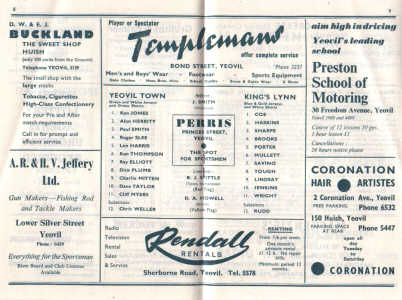 In January there was a small diversion from the internal politics as Templeman went to a meeting of the Southern League Management Committee in London on Sunday 19th to discuss the F.A. proposals for a national Cup competition, at that point provisionally named the Knock-Out Cup, for Non-league clubs. In the subsequent programme (No.13, right) Boardroom Notes expressed concerns about the effect such a competition would have on entry to the F.A. Cup, and doubted Yeovil Town would join in. A centre page spread is shown, as this was the first season in which Yeovil programmes adopted the relatively new style of listing team line-ups rather than showing them in formation. In other respects the content of the programme was very much the same: Boardroom Notes; a general football item - in this issue it was about the England Football Supporters' Association and travel to Mexico 1970; Supporters' Club Notes; League Tables; Team Line-ups; Our Visitors - the club; Our Visitors - the players; The last time we met at Huish - match report; Appearances - stats; Goalscorers - stats; Fixtures and Results. This one is for a mid-week Southern League fixture against King's Lynn. Kick-off was at 7.30, on January 22nd. Final score: 4-0. Formal programmes in this format were no longer being produced for the Floodlight League or the Somerset Professional Cup.
In January there was a small diversion from the internal politics as Templeman went to a meeting of the Southern League Management Committee in London on Sunday 19th to discuss the F.A. proposals for a national Cup competition, at that point provisionally named the Knock-Out Cup, for Non-league clubs. In the subsequent programme (No.13, right) Boardroom Notes expressed concerns about the effect such a competition would have on entry to the F.A. Cup, and doubted Yeovil Town would join in. A centre page spread is shown, as this was the first season in which Yeovil programmes adopted the relatively new style of listing team line-ups rather than showing them in formation. In other respects the content of the programme was very much the same: Boardroom Notes; a general football item - in this issue it was about the England Football Supporters' Association and travel to Mexico 1970; Supporters' Club Notes; League Tables; Team Line-ups; Our Visitors - the club; Our Visitors - the players; The last time we met at Huish - match report; Appearances - stats; Goalscorers - stats; Fixtures and Results. This one is for a mid-week Southern League fixture against King's Lynn. Kick-off was at 7.30, on January 22nd. Final score: 4-0. Formal programmes in this format were no longer being produced for the Floodlight League or the Somerset Professional Cup.
By this time the rumour mill that Saunders was off was working overtime. On February 19th he was appointed manager of Oxford United, then lying second from bottom in Division 2. Don Travis and Doug Hunt took over as joint caretakers. The team did quite well in the minor competitions, the Floodlight League and the County Cup, which was shared with Frome after the two legs ended 4-4 on aggregate. But in the Southern League the side fell away badly, winning only four out of the last fifteen games, and finishing 8th. Saunders tried to asset strip the team and take Cliff Myers and Dick Plumb with him, offering �4,500 for the pair. The board countered with a price of �7,000, rightly calculating this would be too much for Oxford. The departure is first referenced in a programme in the March 1st issue for the match against Hereford United (No.15, left). As can be seen the cover from the previous two seasons had been retained. Owing to some peculiar fixture planning by the Southern League and postponements because of weather it was only the third home league game since December 7th. This was no help to cash flow.
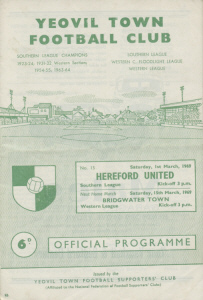 Ironically soon after Saunders left an issue that has caused much antagonism between himself and the directors went the way he had wanted all along. The F.A. announced that the new competition, now to be called the F.A. Trophy, would not effect F.A. Cup qualification and would have a Wembley Final. Yeovil applied for entry the following season and withdrew from the Western Counties Floodlight League as a consequence. The majority on the board would not budge on the Reserves though, and despite having finished bottom of the Western League for the third year in a row it was entered again.
Ironically soon after Saunders left an issue that has caused much antagonism between himself and the directors went the way he had wanted all along. The F.A. announced that the new competition, now to be called the F.A. Trophy, would not effect F.A. Cup qualification and would have a Wembley Final. Yeovil applied for entry the following season and withdrew from the Western Counties Floodlight League as a consequence. The majority on the board would not budge on the Reserves though, and despite having finished bottom of the Western League for the third year in a row it was entered again.
That season's operating loss had doubled to �6,015, and the overdraught had gone up further, though the figures were not made public at that time. Four players, including Dave Taylor who went to Bath City, were released in a meeting that developed into a huge row with people storming out. Further meetings were held, as everyone agreed that the club was in such a perilous financial situation that the Board of Directors and the Supporters' Club needed to make common cause to keep Yeovil Town in existence. However although espousing fine sentiments, when it came to it the rifts and hatreds were so deep that no one seemed able to swallow a reconciliation. Secretary Ken Little declared that "the board would like to remove the Supporters' Club and me in particular". The club denied it, but responded by barring Supporters' Club functions from the premises. At another meeting involving club chairman Edmund Templeman and the Supporters' Club members almost the whole Committee was re-elected. Five days later Templeman held a directors' meeting in his home and the decision was taken to expel the entire Supporters' Club Committee from Yeovil Town Football Club. The committee was accused of not handing over money due to the club, and of not providing financial statements. All the Supporters' Club's assets on club property were seized. The Supporters' Club responded by saying it would carry on with its normal activities as best it could, signing up and renewing memberships and raising money, but freeze all such income and not hand anything over to the club until matters were resolved. The board declared it had: "...no confidence in the Supporters' Club. So long as the present executive committee and officers hold office we will have no dealings with them".
With friends in both camps Bryan Moore must have been particularly pleased - not- that the club had foisted yet another role on him, that of Public Relations Officer, as he struggled to prevent Yeovil Town from ripping itself apart and to present some acceptable face to an aghast press, fans and general public. At the end of July the Board of Directors set up a new supporters' organisation called the Green and White Club. The directors appointed Major Doug Holmes and Alwyn Lugg as chairman and vice-chairman respectively, with Dick Donovan as a full-time secretary, to run the new club. Ken Little resigned from the Supporters' Club as a sacrificial gesture towards compromise, but was back in office again within hours when a meeting was held by the members to pass a unanimous vote of confidence in him. So as July moved into August there were two supporters' clubs, both signing up members and running fund raising activities in opposition to each other, one recognised by the Football Club, the other not.
Into this utter shambles walked Mike Hughes, Yeovil Town's youngest ever manager at 28.
|

 Away Programmes and other items
Away Programmes and other items
|
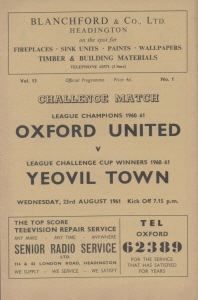
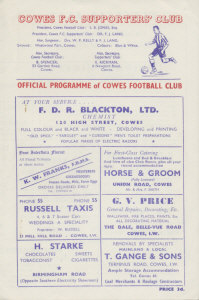 To provide a comparison each decade on Yeovil will end with a few examples of programmes from away matches. There is no particular rationale to those chosen, other than they are issues the author happens to like, finds interesting, or commemorate significant matches in the history of Yeovil Town. On occasion this section will also be used to diplay items other than programmes produced by the club.
To provide a comparison each decade on Yeovil will end with a few examples of programmes from away matches. There is no particular rationale to those chosen, other than they are issues the author happens to like, finds interesting, or commemorate significant matches in the history of Yeovil Town. On occasion this section will also be used to diplay items other than programmes produced by the club.
The programme (top left) is for the Southern League Challenge Cup on Wednesday 23rd August 1961 versus Oxford United, their second match of the season and first at home. The tradition was the League Champions played hosts to the League Cup holders, so the tie kicked off at 7.15 p.m. at Manor Park, which the programme proudly informs us had at last been bought by the club over the close season after years of renting. Perhaps fans had still not got used to the new name, as with the opposition only changing it the previous season inside there is reference to "Oxford United (Headington United)". Oxford won 2-0. The programme itself (No.1) is a sixteen page issue on extremely thin fawn coloured paper measuring 5�" x 8�". The price was 4d. Forthcoming home fixtures are on the back. Around 60% of total space is taken up with advertising. Page 7 carried the fixture lists for the season, with the First Team playing once again in the Southern League Premier Division, the Reserves in the Metropolitan League, and an 'A' Team in the Hellenic League. The First Team had begun the league campaign well with a 3-0 win away to Weymouth, and would go on to successfully defend their title and gain entry to the Football League at the expense of Accrington Stanley. There is also mention of a Youth Team and their draw for the Preliminary Round of the F.A. Youth Cup, but no mention of which league they would be competing in.
The second (top right) is one of only three examples of which I know of the Glovers playing a competitive match 'overseas', if in this case the sea was merely The Solent. It is for a F.A. Cup Fourth Qualifying Round tie played at Westwood Park versus Cowes, then in the Hampshire League Division One, in 1963-64. The issue is a single sheet of thick non-gloss creamy paper printed on both sides and folded to give six pages at 6" x 9�" priced at 3d. Apart from the two red banners on the front ink is mid-blue throughout. There are only three items of content: brief club notes penned by "Yachtsman", the Hants League table, and the line-ups of the two teams - covering the equivalent of a page in total. All the remainder is advertising. Yeovil won the tie 1-0 and went on to reach the Third Round, defeating Southend United and Crystal Palace on the way, before going out to Bury.
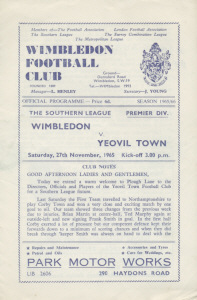
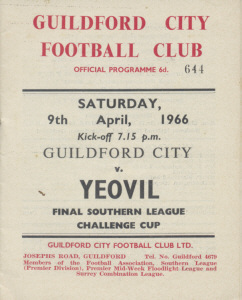 The next (middle left) is from a Southern League match against Wimbledon. Whatever did happen to them? As far as I am aware this was the first ever meeting between the two clubs. Wimbledon had abandoned their amateur status and switched from the Isthmian League to the Southern League Division One in 1964-65, gaining promotion to the Premier Divison as runners-up at their first attempt. The issue is 12 pages priced at 6d, blue ink throughout on an off-white paper. There is a good range of content with advertising taking up only a little over a quarter of the space. Page size is 5�" x 8�".
The next (middle left) is from a Southern League match against Wimbledon. Whatever did happen to them? As far as I am aware this was the first ever meeting between the two clubs. Wimbledon had abandoned their amateur status and switched from the Isthmian League to the Southern League Division One in 1964-65, gaining promotion to the Premier Divison as runners-up at their first attempt. The issue is 12 pages priced at 6d, blue ink throughout on an off-white paper. There is a good range of content with advertising taking up only a little over a quarter of the space. Page size is 5�" x 8�".
The following season Wimbledon were to switch to the mini-booklet that quite a number of clubs adopted in the Sixties. And the next example (middle right) is of that type. However whilst Wimbledon were to go on to great things the producers of this programme would be extinct in a decade, after even a last gasp merger with Dorking had failed to save them. It is the second leg of the Southern League Cup Final of 1965-66 played on 9th April, a Saturday but an evening kick-off. Twenty-four pages at 4�" x 5�", it cost 6d. There was an excellent ratio of content to advertising with only eight pages of commercial material. The club was clearly already aware it was in trouble as a long article about the establishment of a "S.O.S. Fund Committee" dominates two pages. Yeovil took a 2-1 advantage from the first leg to Josephs Road, and ground out a 0-0 to win the trophy for the fourth time.
At the beginning of the 1958-59 season the Supporters' Club Committee had taken the decision to produce the first seasonal Yeovil Town Handbook, the only previous venture into this field being the Silver Jubilee publication ten years before. Another was published in 1959-60 and then, after a gap three seasons, another in 1963-64. Sadly this was to be the final one; unlike many clubs Yeovil Town never managed to sustain the seasonal Handbook tradition. The last issue had thin card covers holding 28 pages on high gloss paper. The price was one shilling. The back and inside of the covers were taken up with advertising, as were thirteen of the pages. Contents were the Chairman's Remarks, Secretary's Report, and a brief survey of Yeovil's history written by F.D.Voisey. There were then six pages reviewing the Southern League and its clubs, both Premier and First Divisions, including a summary of each team's historical playing record against Yeovil. Two pages were given over to the Western League. Page 11 is shown (bottom left), and records the Brewery End at Huish, at the Second Round F.A. Cup tie against Swindon Town on 24th November 1962, and in the lower photo after snow storms in the New Year later that same season. The campaign this handbook presaged would see Yeovil Town's second post-War Southern League Championship.
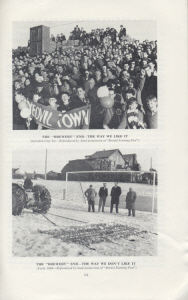
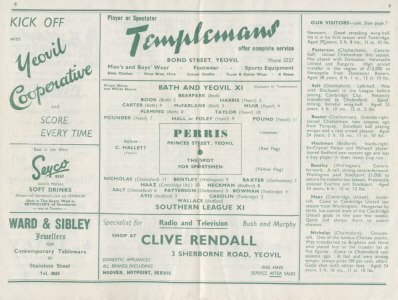
Perhaps the final selection shouldn't be in this section as it is an official Yeovil programme, with a seasonal issue number of No.24. However it is something of an oddity, recording as it does a charity match played at Huish on Wednesday 11th March 1964 between a combined Bath City and Yeovil Town XI and a Southern League XI drawn from six other clubs. A Southern League Secretaries and Managers Association had been formed two years before, and its most important function was to run a Benevolent Fund to assist club secretaries and managers incapacitated by illness or injury, or their families in cases of premature death. Apart from the Introduction and Supporters' Club Notes, penned by Bryan Moore, which concentrated on the charity aspect, the remainder of the issue was a normal Yeovil Town programme focusing on all the usual features related to the club. The 24th Portrait gallery of the season reviewed the career of Stan Abbott, who by then had been with the club since 1919 and could boast of having played at the old Pen Mill ground before the club's move to Huish. He had captained the club, and continued playing until 1930, then moved to the post of First Team Trainer which he held until Doug Hunt took over the job in 1958. Stan then pursued the same role with the Reserves. He would retire in the 1965 close season at the age of 70 having served the club for 46 years.
Back to 1940s
Back to 1950s
Forward to 1970s (in progress)
|
|
 |
 |
 |
 |
 |
|


